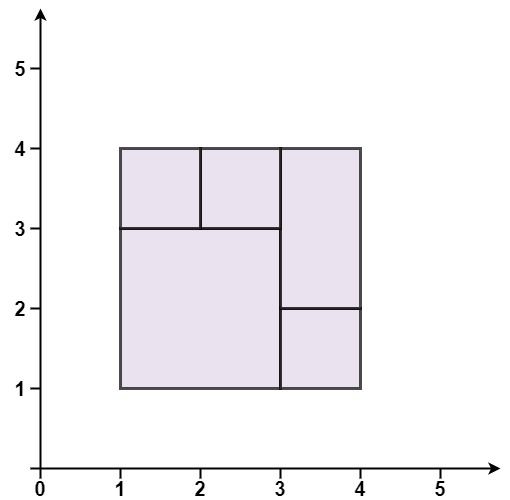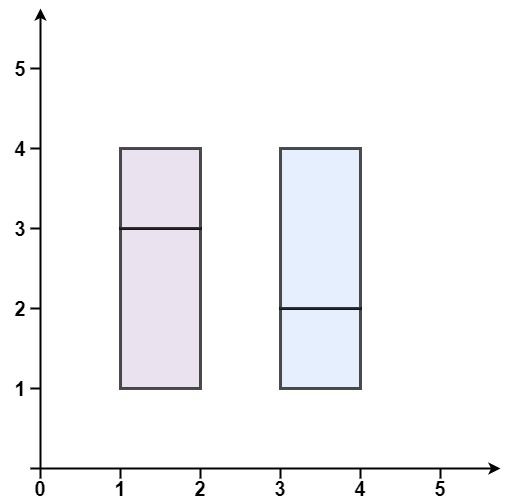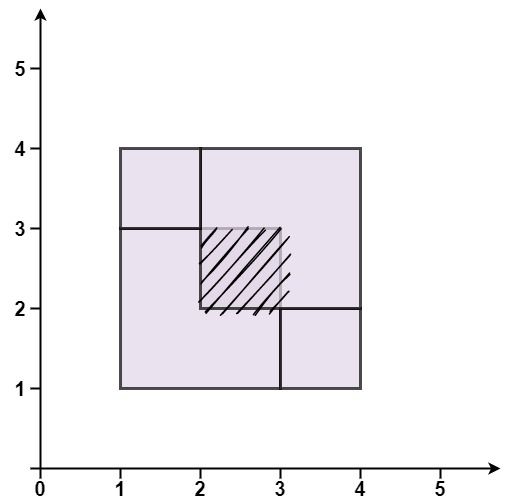Array
Line Sweep
Description
Given an array rectangles where rectangles[i] = [xi , yi , ai , bi ] represents an axis-aligned rectangle. The bottom-left point of the rectangle is (xi , yi ) and the top-right point of it is (ai , bi ).
Return true if all the rectangles together form an exact cover of a rectangular region .
Example 1:
Input: rectangles = [[1,1,3,3],[3,1,4,2],[3,2,4,4],[1,3,2,4],[2,3,3,4]]
Output: true
Explanation: All 5 rectangles together form an exact cover of a rectangular region.
Example 2:
Input: rectangles = [[1,1,2,3],[1,3,2,4],[3,1,4,2],[3,2,4,4]]
Output: false
Explanation: Because there is a gap between the two rectangular regions.
Example 3:
Input: rectangles = [[1,1,3,3],[3,1,4,2],[1,3,2,4],[2,2,4,4]]
Output: false
Explanation: Because two of the rectangles overlap with each other.
Constraints:
1 <= rectangles.length <= 2 * 104 rectangles[i].length == 4-105 <= xi < ai <= 105 -105 <= yi < bi <= 105
Solutions
Solution 1
Python3 Java C++ Go
1
2
3
4
5
6
7
8
9
10
11
12
13
14
15
16
17
18
19
20
21
22
23
24
25
26
27
28
29
30
31
32 class Solution :
def isRectangleCover ( self , rectangles : List [ List [ int ]]) -> bool :
area = 0
minX , minY = rectangles [ 0 ][ 0 ], rectangles [ 0 ][ 1 ]
maxX , maxY = rectangles [ 0 ][ 2 ], rectangles [ 0 ][ 3 ]
cnt = defaultdict ( int )
for r in rectangles :
area += ( r [ 2 ] - r [ 0 ]) * ( r [ 3 ] - r [ 1 ])
minX = min ( minX , r [ 0 ])
minY = min ( minY , r [ 1 ])
maxX = max ( maxX , r [ 2 ])
maxY = max ( maxY , r [ 3 ])
cnt [( r [ 0 ], r [ 1 ])] += 1
cnt [( r [ 0 ], r [ 3 ])] += 1
cnt [( r [ 2 ], r [ 3 ])] += 1
cnt [( r [ 2 ], r [ 1 ])] += 1
if (
area != ( maxX - minX ) * ( maxY - minY )
or cnt [( minX , minY )] != 1
or cnt [( minX , maxY )] != 1
or cnt [( maxX , maxY )] != 1
or cnt [( maxX , minY )] != 1
):
return False
del cnt [( minX , minY )], cnt [( minX , maxY )], cnt [( maxX , maxY )], cnt [( maxX , minY )]
return all ( c == 2 or c == 4 for c in cnt . values ())
1
2
3
4
5
6
7
8
9
10
11
12
13
14
15
16
17
18
19
20
21
22
23
24
25
26
27
28
29
30
31
32
33
34
35
36
37
38
39
40
41
42
43
44
45
46
47
48
49
50
51
52
53
54
55
56
57
58
59
60
61
62
63
64 class Solution {
public boolean isRectangleCover ( int [][] rectangles ) {
long area = 0 ;
int minX = rectangles [ 0 ][ 0 ] , minY = rectangles [ 0 ][ 1 ] ;
int maxX = rectangles [ 0 ][ 2 ] , maxY = rectangles [ 0 ][ 3 ] ;
Map < Pair , Integer > cnt = new HashMap <> ();
for ( int [] r : rectangles ) {
area += ( r [ 2 ] - r [ 0 ] ) * ( r [ 3 ] - r [ 1 ] );
minX = Math . min ( minX , r [ 0 ] );
minY = Math . min ( minY , r [ 1 ] );
maxX = Math . max ( maxX , r [ 2 ] );
maxY = Math . max ( maxY , r [ 3 ] );
cnt . merge ( new Pair ( r [ 0 ] , r [ 1 ] ), 1 , Integer :: sum );
cnt . merge ( new Pair ( r [ 0 ] , r [ 3 ] ), 1 , Integer :: sum );
cnt . merge ( new Pair ( r [ 2 ] , r [ 3 ] ), 1 , Integer :: sum );
cnt . merge ( new Pair ( r [ 2 ] , r [ 1 ] ), 1 , Integer :: sum );
}
if ( area != ( long ) ( maxX - minX ) * ( maxY - minY )
|| cnt . getOrDefault ( new Pair ( minX , minY ), 0 ) != 1
|| cnt . getOrDefault ( new Pair ( minX , maxY ), 0 ) != 1
|| cnt . getOrDefault ( new Pair ( maxX , maxY ), 0 ) != 1
|| cnt . getOrDefault ( new Pair ( maxX , minY ), 0 ) != 1 ) {
return false ;
}
cnt . remove ( new Pair ( minX , minY ));
cnt . remove ( new Pair ( minX , maxY ));
cnt . remove ( new Pair ( maxX , maxY ));
cnt . remove ( new Pair ( maxX , minY ));
return cnt . values (). stream (). allMatch ( c -> c == 2 || c == 4 );
}
private static class Pair {
final int first ;
final int second ;
Pair ( int first , int second ) {
this . first = first ;
this . second = second ;
}
@Override
public boolean equals ( Object o ) {
if ( this == o ) {
return true ;
}
if ( o == null || getClass () != o . getClass ()) {
return false ;
}
Pair pair = ( Pair ) o ;
return first == pair . first && second == pair . second ;
}
@Override
public int hashCode () {
return Objects . hash ( first , second );
}
}
}
1
2
3
4
5
6
7
8
9
10
11
12
13
14
15
16
17
18
19
20
21
22
23
24
25
26
27
28
29
30
31
32
33
34
35
36
37
38
39
40
41 #include <bits/stdc++.h>
using namespace std ;
class Solution {
public :
bool isRectangleCover ( vector < vector < int >>& rectangles ) {
long long area = 0 ;
int minX = rectangles [ 0 ][ 0 ], minY = rectangles [ 0 ][ 1 ];
int maxX = rectangles [ 0 ][ 2 ], maxY = rectangles [ 0 ][ 3 ];
using pii = pair < int , int > ;
map < pii , int > cnt ;
for ( auto & r : rectangles ) {
area += ( r [ 2 ] - r [ 0 ]) * ( r [ 3 ] - r [ 1 ]);
minX = min ( minX , r [ 0 ]);
minY = min ( minY , r [ 1 ]);
maxX = max ( maxX , r [ 2 ]);
maxY = max ( maxY , r [ 3 ]);
++ cnt [{ r [ 0 ], r [ 1 ]}];
++ cnt [{ r [ 0 ], r [ 3 ]}];
++ cnt [{ r [ 2 ], r [ 3 ]}];
++ cnt [{ r [ 2 ], r [ 1 ]}];
}
if ( area != ( long long ) ( maxX - minX ) * ( maxY - minY ) || cnt [{ minX , minY }] != 1 || cnt [{ minX , maxY }] != 1 || cnt [{ maxX , maxY }] != 1 || cnt [{ maxX , minY }] != 1 ) {
return false ;
}
cnt . erase ({ minX , minY });
cnt . erase ({ minX , maxY });
cnt . erase ({ maxX , maxY });
cnt . erase ({ maxX , minY });
return all_of ( cnt . begin (), cnt . end (), []( pair < pii , int > e ) {
return e . second == 2 || e . second == 4 ;
});
}
};
1
2
3
4
5
6
7
8
9
10
11
12
13
14
15
16
17
18
19
20
21
22
23
24
25
26
27
28
29
30
31
32
33
34
35
36
37
38
39
40
41
42
43
44
45 type pair struct {
first int
second int
}
func isRectangleCover ( rectangles [][] int ) bool {
area := 0
minX , minY := rectangles [ 0 ][ 0 ], rectangles [ 0 ][ 1 ]
maxX , maxY := rectangles [ 0 ][ 2 ], rectangles [ 0 ][ 3 ]
cnt := make ( map [ pair ] int )
for _ , r := range rectangles {
area += ( r [ 2 ] - r [ 0 ]) * ( r [ 3 ] - r [ 1 ])
minX = min ( minX , r [ 0 ])
minY = min ( minY , r [ 1 ])
maxX = max ( maxX , r [ 2 ])
maxY = max ( maxY , r [ 3 ])
cnt [ pair { r [ 0 ], r [ 1 ]}] ++
cnt [ pair { r [ 0 ], r [ 3 ]}] ++
cnt [ pair { r [ 2 ], r [ 3 ]}] ++
cnt [ pair { r [ 2 ], r [ 1 ]}] ++
}
if area != ( maxX - minX ) * ( maxY - minY ) ||
cnt [ pair { minX , minY }] != 1 ||
cnt [ pair { minX , maxY }] != 1 ||
cnt [ pair { maxX , maxY }] != 1 ||
cnt [ pair { maxX , minY }] != 1 {
return false
}
delete ( cnt , pair { minX , minY })
delete ( cnt , pair { minX , maxY })
delete ( cnt , pair { maxX , maxY })
delete ( cnt , pair { maxX , minY })
for _ , c := range cnt {
if c != 2 && c != 4 {
return false
}
}
return true
}
GitHub



